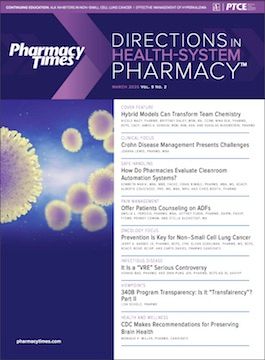Publication
Article
Pharmacy Practice in Focus: Health Systems
340B Program Transparency: Is It "Transfairency"?
Author(s):
What should covered entities do to prepare for increased reporting requirements?
There is a lot going on in health care, with the industry changing more rapidly than it has in decades, and every change has a ripple effect.
For the 340B program, those changes have led to an increased call for transparency that often puts a burden on covered entities and compromises their ability to serve vulnerable populations.
This is part 2 of a 2-part article on this topic. Part 1, in the January issue provided an overview of the economic, political, social, and technological trends shaping health care and illustrated how the 340B program fits into that landscape.
What Is “Transfairency”?
Although the government and pharmaceutical manufacturers are calling for increased transparency and reporting from covered entities, we have seen very little transparency on the part of manufacturers. This is where “fair” comes into play.
For example, consider the Civil Monetary Penalties ruling, in which the online posting of 340B ceiling prices was delayed 5 times over the course of 10 years before the information was made public.
After a very long road, on April 1, 2019, the Health Resources and Services Administration (HRSA) made available online a way for covered entities to view the ceiling prices, or maximum amount drug manufacturers are allowed to charge, for drugs under the 340B program.1 The requirement for such a website was enacted into law in 2010 under the Obama administration, and the final regulation implementing the changes was issued in January 2017, but it encountered many delays since then.
This is just 1 example in which stakeholders are not exercising “transfairency” or the open sharing of information on all sides. Some additional information that would be beneficial to covered entities in the interest of “transfairency” include the following:
Good faith inquiries. Manufacturers often contact covered entities to inquire why purchasing on certain drugs in the 340B space may have gone up. The HRSA encourages covered entities to respond to these “good faith” inquiries, yet may have no idea how often they are occurring among their peers. Are there certain manufacturers who look for this information more than others? Do they send out 200 such inquiries a year or 2000?
Number of manufacturer audits. Covered entities have no insight into how often manufacturer audits occur. Although manufacturers must notify the Office of Pharmacy Affairs when they conduct an audit, covered entities have no way to know how their frequency of audits compares with their peers or which manufacturers tend to conduct such audits more frequently.
Penny pricing. Whenever a manufacturer increases the price of a 340B drug more quickly than the rate of inflation, it is subject to a “penny pricing” penalty—that is, it is then required to sell that drug to covered entities the following quarter at a price of 1 penny. Manufacturers claim this happens frequently, which is a reason they say that the 340B program is costing them money, yet we have no way to know how often this really occurs, as there are limitations in the recently developed online reporting tool from the HRSA. There is no publicly available report to demonstrate the frequency of this penalty.
Pharmacy benefit manager (PBM) rebates. On July 1, 2019, the Office of Inspector General released a report in which it found that in 2014, pharmacy benefit managers (PBMs) missed out on potential rebates of up to $74.7 million on Medicare Part D prescriptions, because those drugs were filled through the 340B program.2 PBMs, or “sponsors,” typically receive rebates from drug manufacturers in exchange for offering those drugs on their formularies and playing middleman between insurance companies and manufacturers. However, when Medicare Part D drugs are filled through the 340B program, manufacturers are required to sell those 340B drugs to covered entities at a deep discount and, in an effort to avoid paying out double or stacked rebates, the manufacturers therefore do not offer rebates on those 340B drugs to the PBMs. Yet covered entities cannot know for certain how many rebates manufacturers are refusing to pay out in circumstances like these, because, again, no reporting requirements or transparency exist on the manufacturer side.
Specialty drugs. Many manufacturers have been limiting access to certain drugs by distributing them only through specialty pharmacies. When this happens, it becomes more difficult for covered entities to access these drugs, and when they do access them, it may not be at the 340B price. We know that the number of drugs being put into this limited-distribution, specialty-pharmacy category has been increasing over the years, as noted by the Office of Pharmacy Affairs’ online posting of letters from manufacturers. What we do not know is how many drugs actually fall into that category at any given time. There is no requirement for pharmaceutical manufacturers to provide a list.
These examples illustrate that transparency can and should go both ways. When calling for more reporting and transparency, government entities, pharmaceutical manufacturers, and other stakeholders must think about the limits of what is fair, not a burden, and practical.
Future of Transparency
As the push for transparency around 340B continues, covered entities must be prepared. It will be imperative to keep track of 340B savings, how they are being used whether to build oncology clinics or provide prescriptions at discounts, and how they can prove compliance. To execute these responsibilities with confidence, covered entities should engage with partners that have not only the right technology but also the right level of 340B program expertise.
As hospital leaders think about the future of the 340B program and what reporting will look like, the role of the 340B vendor is 3-fold: to develop a reporting infrastructure to match the needs of the future; to integrate and centralize information to create efficiencies and protect sensitive data; and to engage with stakeholders on the health system’s behalf to help the covered entity understand the elements of the 340B program that are most important for empowering it to meet the community needs.
With the right partners in one’s corner, maintaining 340B program compliance and integrity is possible, regardless of the changes faced. Transparency is a team effort.
Lisa Scholz, PharmD, is head of industry relations at Sentry Data Systems in Deerfield Beach, Florida, a 340B management and compliance company.
REFERENCES
- 340B Office of Pharmacy Affairs information system. Health Resources & Services Administration website. hrsa.gov/opa/340b-opais/index.html. Updated March 2019. Accessed January 31, 2020.
- US Department of Health and Human Services. Medicare Part D rebates for prescriptions filled at 340B contract pharmacies. Office of Inspector General website. oig.hhs.gov/oas/reports/region3/31600002.asp. Published July 1, 2019. Accessed February 3, 2020.







